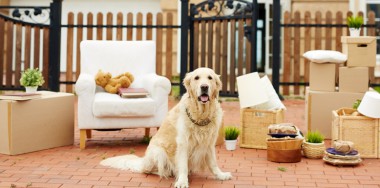
Moving House With Your Dog
In particular, when you have a long distance move ahead of you, you have to decide how you will move both your items and your furry friends to your new location. If you have a dog that doesn't adjust to change well or an older dog who needs a little more TLC that the average, this new change can possibly have a negative impact on their health, which is why you need to take measures to lower the risk of anxiety in your pooch.
Long Car Rides With Your Dog
If your move is local and you plan to drive from your old place to your new one, keep in mind a dog will normally lengthen the time span of the trip. They usually need to get out and stretch their legs and muscles and take bathroom breaks every few hours which naturally adds extra minutes to the trip. In addition, plan out your accommodations (if necessary) in advance because finding a pet friendly location isn't always easy. An older dog may also not be prepared to make a longer trip if they were left unsupervised and suffer from health issues. As a result, you should speak with the vet about the safest method of travel.
Keep Your Dog Tags / Microchip Details Updated
The contact information on your dog tags or dog’s should be updated as soon as possible once you’ve moved. Moving to a new home will increase the risk of your dog making a run for it and getting lost. This can also happen when moving house with cats too.
Want to Wash Everything? Wait One Minute!
Before you decide to wash everything in the home to start fresh, think twice about it for your furry amigo. Your gut might tell you to wash everything, but you should keep your dog's possessions unwashed. You want them to smell just like your dog because it will give them a familiar scent in the new home. This will also help them to feel like they’re in their element in his new location. It deals directly with moving house dog anxiety, which is that they don’t have anything familiar to hold onto in their new environment.
Create a Safe Space
As mentioned previously, when moving with a dog, the danger of them running away increases. Especially during the packing stage when the boxes come out, it can feel confusing to them. They may feel upset or scared as the suitcases and boxes take over the home. As a result, they could either attempt to run away or hide. To don your best to prevent this, set aside a safe space where your dog feels comfortable and won't get lost or hurt. Try to look for structural risks within the home and yard that could lead to your dog escaping and running away.
Dog Anxiety Due to House Moving: Patience, Patience, Patience!
As your dog moves into their new environment, they will sniff around and discover all they can about their new surroundings. Even if they decide to hide for a while, that's not the end of the world. As long as they understand where they can be fed and go toilet. Let them come out on their own terms, when they’re ready because as helps them to adjust and feel safe in their new environment. For a little while, you may see a slight change in behaviour. This can include pacing, barking, over eating (or lack of appetite) and protective behaviours. Remember, they need time to adjust to their new home just like people do.
Moving House with Your Dog: Extra Loving Attention
Moving house dog anxiety can be greatly reduced with a little bit of loving attention. It goes a long way in helping your pet to feel at home in their new environment. If you notice bad behaviour during this time, it may be the direct result of the discomfort from the move. To try and help ease the problem, try to give your dog a sense of purpose. An emotionally healthy dog understands their sense of purpose in the hierarchy of the home. Dogs, by nature, have an instinctual desire to work. Whether it's protecting your home or livestock, giving them a sense of purpose can lower the number of misbehaving outbursts from them. If they start to misbehave big time, you may want to hire a dog trainer.








